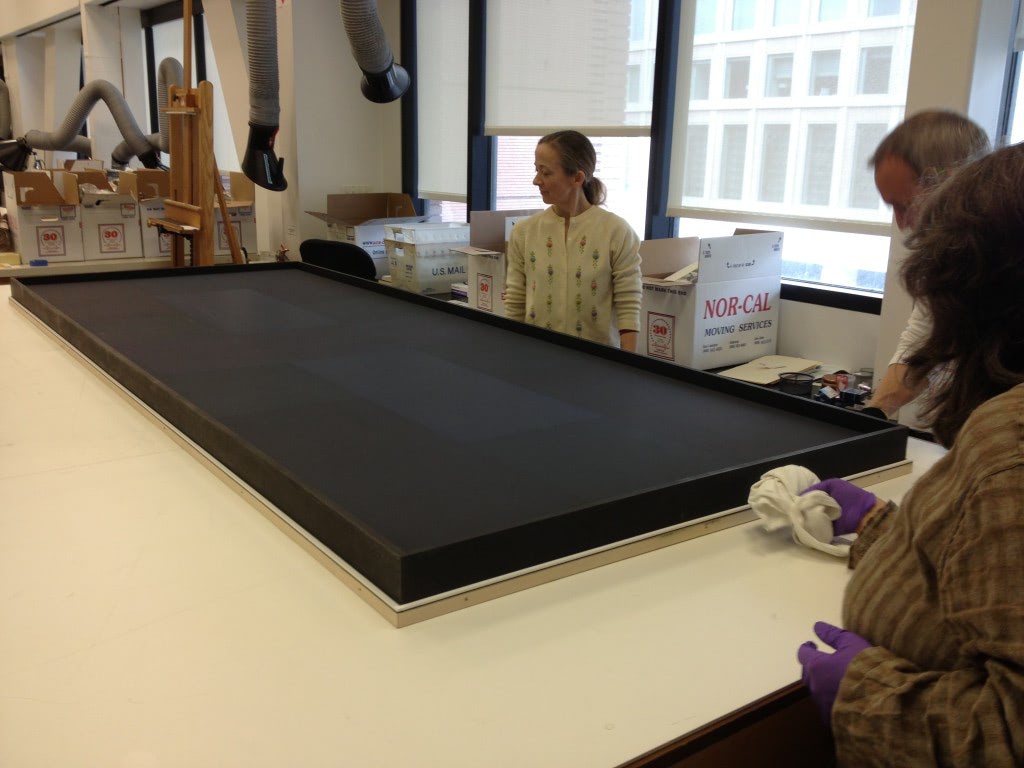A memorable framing project presented itself to us in late 2012: Paula De Cristofaro, the paintings conservator at the San Francisco Museum of Modern Art (SFMOMA), contacted me concerning a 1958 Ad Reinhardt painting. With a canvas measuring 40-by-108 inches, the work is encompassed by an artist-made floater frame. Its delicate surface had required some conservation treatment at the SFMOMA conservation laboratory, and to further protect the painting, we were asked to consult on how to glaze it without unduly compromising the viewing experience.
A member of the American Abstract Artists, Reinhardt painted in New York from the 1930s through the ’60s. His work includes compositions of geometrical shapes to works in different shades of the same color, including his well-known “black” paintings. He also is recognized for his illustrations and comics, and wrote and lectured extensively on the controversial topic “art as art.”
Arriving at an appropriate frame design to meet these ends was a collaboration between Sterling Art Services, Zlot-Buell + Associates, and the curatorial and conservation staff at SFMOMA. This is an artwork with such a delicate surface that, unglazed, one must speak and breathe with care in front of it.
From the start, we gravitated toward Optium® Acrylic as the glazing material of choice. We intuited that Optium’s lighter weight relative to equivalent glass products would be desirable for our application. Since the delicate painting has not been immune to the effects of age and handling, we were attracted to the resiliency of acrylic for maximum protection of an irreplaceable artwork. Overall, however, we were most interested in the clarity of Optium to allow viewers to take in the subtleties of the rectilinear composition, a composition of dark dusky blues and purples.
Initially, we considered removing the artist frame to be archived separately. The canvas could then be housed in a welded aluminum shadowbox, situated so that the frame face and space around the painting would mimic the proportions of the original artist’s frame.
We contacted our colleagues at SmallCorp in Greenfield, Massachusetts, who we trust for their crisp and thoughtful workmanship. They dissuaded us from expecting a ½-inch face frame at this size to sufficiently carry the weight of the Optium, stating ¾-inch would be necessary. Then, we ascertained that to attempt removal of the frame would be too risky. Consisting of a simple, two-faceted edge; composed of eight separate, side-nailed strips of wood; and hand-painted after assembly, it became clear that once removed, the frame would never go back together again.
Our design process reoriented around the idea of housing the entire object, frame as well as painting, with the ¾-inch aluminum face completely covering the ½-inch original frame face. After testing this approach by mocking up a corner over a small test painting made by De Cristofaro, we were frustrated to see that this also did not do justice to Reinhardt’s work, as it cast a shadow on the painting.


Experimenting with the combinations of frame, space, and light with a mockup artwork, we discovered that if we pulled the aluminum frame face back, it allowed light to play on the painting. While this would reveal most of the original frame inside of the new aluminum one, we were delighted with this discovery which suggested that the result would not feel overbuilt. We thus solidified the design: a ¾-by-4-inch welded aluminum SmallCorp powdercoat black frame, built to a sight size that would visually bisect the ½-inch outer edge of the artist’s frame. To this, we applied:
- A graphite finish, rubbed by hand to resemble the value and patina of the original;
- Glazing to be 6mm Optium Museum®Acrylic;
- Micro-chamber emulsion-coated 4mm Dibond® foam core spacers built just deep enough to ensure space between the original frame and the inside of the Optium; and
- A support structure consisting of a cleated basswood strainer faced with a sheet of 3mm Dibond.
Because of the acidic nature of the original backing, it was to be archived separately, with the Dibond support panel as the new de facto backer. We applied Artcare™ foam core strips to the face of the Dibond support, mirroring the stretcher shape to ensure that when we screwed it into place through the reverse, the canvas would be fully supported.

It was crucial for the framing to come off without a hitch. The design and fabrication process took place as the SFMOMA conservation department was preparing to move their laboratory in advance of the museum’s major expansion, currently underway. In the week before the scheduled move-out date, we received the aluminum frame, applied its graphite finish and installed the Optium. Seventy-two hours before moving day, art handlers picked up the frame from Sterling and transported it to the museum. The next day, I along with two of our staff, Laura Blom and Kit Adamo, worked with De Cristofaro and the preparatory staff at SFMOMA to successfully mount the painting into the frame.


The Optium performed even better than we had hoped, to our collective approval and delight. The soft energy of its palette emerges quietly-and now, one can breathe and speak in front of the painting!

Share this Article:
This article is intended for educational purposes only and does not replace independent professional judgment. Statements of fact and opinions expressed are those of the author(s) individually and, unless expressly stated to the contrary, are not the opinion or position of Tru Vue or its employees. Tru Vue does not endorse or approve, and assumes no responsibility for, the content, accuracy or completeness of the information presented.
